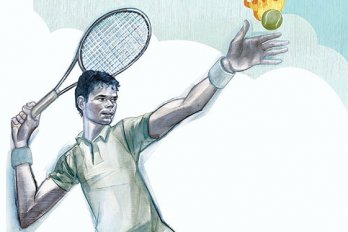When I was seven, I committed one of my first conscious acts of rebellion: I snuck down to the basement to watch Beverly Hills, 90210. In the first episode I saw, teenagers Kelly Taylor, a sultry blonde, and taciturn, James Dean–lite bad boy Dylan McKay gave in to their lust while Brenda Walsh, Dylan's girlfriend and Kelly's best friend, studied in Paris for a semester. Rapt and slightly scandalized, I watched the couple make out in a pool, surrounded by tendrils of steam and accompanied by insistent, sexy synthesizer bleats. This watershed moment in my nascent televisual education sparked a decade-long obsession with teen TV.
As a child, I thought of my fixation on '90s high school soaps such as Beverly Hills, 90210 and Dawson's Creek as a utilitarian exercise, prep work for my future. I watched them dutifully and dispassionately, certain that this was how my own high school experience would play out: angst filled, conflict heavy, and full of salacious encounters. Clandestine viewing sessions, however, turned out to be among my few transgressive acts. I was a nauseatingly boring teen, not unlike the nauseatingly boring adult I have become: bookish, bespectacled, awkward, responsible. In teen soap terms, I was Andrea Zuckerman, Beverly Hills, 90210's bookish, bespectacled buzz kill. Television's muscled quarterbacks and willowy cheerleaders led lives propelled by sex, betrayal, and quippy bons mots, not at all like the cud-chewing monotony of my own contentedly dull existence. These characters were foreign to me—and magnetic. Although now a respectable adult, I religiously follow the genre's latest iterations, Gossip Girl and Pretty Little Liars.
Predating these glamorous modern-day Douglas Sirk melodramas (minus the Sirkian irony) was Degrassi. The humble teen series, which began as Degrassi Junior High and followed its characters into Degrassi High, ran on CBC from 1987 to 1991 (another sequel, Degrassi: The Next Generation, began in 2001 and is in its twelfth season). By the time I got to it in middle school, it had run its course; its only pop currency was as a nostalgic cult classic. A new era of teens watched it in reruns and memorized the lyrics from Zit Remedy's sole hit, “Everybody Wants Something.”
Degrassi's camp value has often overshadowed its cultural significance. Twenty-five years after it debuted, its DNA lives on in every subsequent teen drama; in fact, it inspired Aaron Spelling's Beverly Hills, 90210. However, Degrassi's gritty vérité approach (working-class characters, untrained actors) had more in common with the social realist films of Ken Loach and Mike Leigh than with the brassy designing women and idyllic nuclear families of '80s television. Degrassi treated such issues as teen pregnancy, abortion, and suicide with gravitas. It was the only place on television where kids could see themselves depicted honestly. There has never been anything else like it.
For its first thirty years, television was a casual diversion, episodic and self-contained, filled with sitcoms, variety shows, and cartoons. Then the '80s saw the birth of appointment television; high-octane prime-time soaps such as Dallas and Dynasty teased and titillated, while family-oriented fare like The Cosby Show, Who's the Boss?, and Family Ties encouraged parents and kids to meet on the couch for quality time.
One conspicuous absence was the lack of scripted programs for teenagers, a niche waiting to be filled by an opportunistic producer. Instead, it got Linda Schuyler, a former junior high school teacher who had produced The Kids of Degrassi Street, a series aimed at eight- and nine-year-olds. By 1987, her characters were about to hit puberty, and she saw the chance to create a show for the kids she taught.
Schuyler talks just like your most effervescent, maternal grade eight English teacher. “Education was an important mandate for us, because there was no where for young people to access information about issues like sexually transmitted infections or teen pregnancy,” she says. To find its audience, though, Degrassi needed to be more entertaining than an after-school special. “It was about finding the authenticity of the characters' voices and emotions,” she observes.
“Authenticity” might be a cloaked euphemism for Degrassi's low-grade aesthetic. The show had a grainy, ramshackle quality, with stilted dialogue and a cast of untrained teens who sported the same bad hair, braces, and gawkiness of average fourteen-year-olds. In the early episodes, they stare into the camera, moon faced and terrified, stiffly reciting their lines, often with nation-shaming hoser accents. Nevertheless, the cheap production values didn't diminish the series' achievement in creating a synecdochic reflection of how kids really lived.
Before this, a few children's TV programs, such as Sesame Street and Mister Rogers' Neighborhood, had established themselves as fictive universes that mirrored real-life values and expectations. Degrassi strove to do the same for teens. The cast consisted of twenty or so rotating regulars from various ethnic backgrounds, among them Yick Yu, a second-generation Laotian Canadian nerd in thick glasses (later turned stoner in tie-dye); Bryant Lester “BLT” Thomas, a black football player in a controversial relationship with a white girl; Lucy Fernandez, the bohemian mixed-race daughter of affluent absentee parents; Christine “Spike” Nelson, a single mom nicknamed for her mohawk haircut; and Arthur Kobalewsky and Stephanie Kaye, middle-class Jewish siblings (Stephanie's anglicization of her name was never explained). It was a blatant, brilliant capsule of Canadian multiculturalism.
More nuanced, and consequential, was the deft crystallization of class stratification and income disparity. For the most part, these kids, living on Toronto's then ungentrified east side, resided at the bottom of the middle class. For instance, Lorraine “L. D.” Delacorte was the daughter of a car mechanic, and Melanie Brodie was raised by a frugal single mom. Fedora-topped folk hero Joey Jeremiah lived in a cramped apartment, which did nothing to diminish his bravado. Characters rode buses and streetcars, dressed in the same shabby outfits in multiple episodes (usually because the actors had to wear their own clothes), and spent their allowances sparingly. In many respects, Degrassi was television's answer to the films of John Hughes, which tackled class differences and domestic issues—think of Andie's working-class background in Pretty in Pink, or Bender's abusive father in The Breakfast Club—and endeavoured to depict teen life with some semblance of verisimilitude.
Degrassi 's grassroots approach to social class served as a near-invisible narrative strategy, but it anticipated the show's most memorable legacy: its unflinching, plain-spoken treatment of pregnancy, suicide, interracial dating (a big deal in 1987), and HIV/AIDS. What's more, Degrassi didn't treat its characters with benevolence. Spike's pregnancy at age fourteen—the result of a clumsy first-time sexual encounter with Shane, a baby-faced ninth-grader—didn't end with a convenient miscarriage. Her character spent the remainder of the series as a struggling single parent. Later that season, Shane experimented with LSD, fell off a bridge, and suffered permanent brain damage. Wheels, one of the most popular characters, lost his parents to a drunk driver, and later experienced a breakdown that culminated in a drunk driving incident that killed a child, blinded his friend Lucy, and landed him in prison. In the early years of HIV/AIDS, Dwayne contracted the virus after having unprotected sex with his girlfriend (a thoughtful plot choice in an era when many thought of it as a “gay disease”). In a 1999 cast reunion on the CBC talk show Jonovision, actor Darrin Brown, who played Dwayne, was asked where his character would be now. “Dwayne would probably be dead,” he replied.
For teen audiences, it was comforting to see kids go through the same awkward, and sometimes devastating, experiences. In the pre-Internet days, Degrassi was a rare place where they could find empathy without censure. Parents and teachers preached, peers judged, and educational materials came across as naive, but the program spoke to teenagers on their own level. It made adolescence—an age when you feel as if no one understands you—less alienating. Its integrity and candour established a kinship between the characters and the audience, an intimacy that glossier teen soaps cannot replicate. Degrassi was the prototype, as well as a complete anomaly in television history.
In 1990, Beverly Hills, 90210 premiered. At first, it mimicked Degrassi 's issue-of-the-week model, and then broke off into pure prime-time soap territory, in the Dynasty tradition. The spate of teen dramas that burst onto the airwaves in the late '90s (Dawson's Creek, Felicity, Popular) dispensed with any pretense of authentic representation, and focused instead on intricate love quadrangles. In the 2000s, the same plot structures were recreated in such shows as The OC, One Tree Hill, Gossip Girl, and the revamped 90210 (all except The OC are still on the air). These melodramas swapped relatable adolescents and their middle-class realities with gorgeous twentysomethings masquerading as teens, in increasingly far-fetched storylines. (Over the course of Beverly Hills, 90210's decade-long run, Kelly Taylor joined a cult, was date raped, became addicted to diet pills and later cocaine, shot her aforementioned rapist, and suffered amnesia.)
The sensationalism was matched by a fetishization of affluence; modern teen soaps have eradicated the 99 percent altogether. Every series that followed Degrassi has focused on a select clique of wealthy, popular teens, sometimes with a token poor kid thrown in for contrast: consider Ryan Atwood, the gold-hearted thug from the slums of Chino, California, on The OC ; or Gossip Girl's Humphrey children, who attend private school and live in an enormous loft in Williamsburg, Brooklyn, yet are the show's representation of the impoverished class. Within these vacuums of affluence, the consequences that bound Degrassi to the real world have been erased. While it has become pro forma to feature pregnancy, suicide, domestic abuse, and drug taking, a stark difference exists in how they are handled vis-à-vis Degrassi. On Beverly Hills, 90210, Brenda may survive a pregnancy scare, or Gossip Girl's Nate Archibald might lose his fortune, but in the end the problem is magically erased through the intervention of a parent, the scribble of a signature on a cheque, or a deus ex machina twist of fate.
Contemporary teen soaps don't pretend to have an educational mandate; they are as much works of fantasy as programs about vampires, werewolves, and witches. Yet they deliver a different kind of catharsis, trading education for escapism and reality for romance. Degrassi brought teenagers onscreen, but the shows that came afterward transformed them into creatures of television.
In 2000, seven years after Degrassi went off the air, Linda Schuyler and former writer Yan Moore still worked together, writing for a Coronation Street–like Canadian daytime soap called Riverdale. One day in the shower, Moore had an aha moment: he realized that if they had kept Degrassi going, Spike's daughter, Emma, would be entering junior high. Identifying a need for their brand of authentic storytelling, they resurrected the series, bringing back former cast members Amanda Stepto (Spike), Pat Mastroianni (Joey), and Stefan Brogren (Snake), but centring the action on a new crop of junior high students.
Degrassi: The Next Generation was created in the mould of the original, with a large rotating cast who experienced wet dreams and unrequited love. However, it explored subjects the original did not (TNG features gay and transgendered characters) or could not, such as sexting and cyber-bullying. The kids today are better looking, better dressed, and better actors than their predecessors; the show even produced genuine breakout stars, such as rapper Drake, and actors Nina Dobrev and Shenae Grimes, but in its early years it stuck to its formula of depicting realistic teen characters who grappled with the perils of adolescence.
The new version faces more competition, including the now-defunct “scripted reality” series Laguna Beach and The Hills, replete with affluent characters and low-stakes, high-drama storylines. And, of course, the Internet has muted the educational value of television. Though they still watch plenty of TV, the precocious teens of the new millennium are far more informed about sex and drugs than previous generations were. Moreover, they don't need TV to provide kitchen sink realism; they create that themselves on YouTube, Twitter, Facebook, and blogs. Teen shows had to adapt.
TNG is an amalgam of its Degrassi predecessors and the soapier, sensationalistic shows that followed. TNG is no longer a ground breaker, and the risks are significantly lower. One character pilfers her parents' painkillers and develops a three-episode addiction. Another develops bipolar disorder and then quickly regains his composure—important stuff, sure, but not the Degrassi gut punches of the past.
Yet TNG continues to provide a rare opportunity for teenagers to see themselves, spots and all. The new generation of characters is as earnest as Caitlin Ryan, as eager for approval as Joey Jeremiah, as insecure as Arthur Kobalewsky. They inspire an empathy that gorgeous, wealthy gossip girl Blair Waldorf simply cannot. Degrassi continues to act as a lifeline, a flickering reassurance that someone out there understands.
Come the weekend, as I eat cereal for dinner and regress by a decade, I settle in with my cache of teen dramas. Tucked away on my DVR among the sexed-up teen vampires and precocious Upper East Side private schoolers, my weekly dose of Degrassi awaits. The dialogue remains cringe-inducingly earnest and the performances awkward—that's what makes it authentic. While it may no longer be my Degrassi, it's someone's.
This appeared in the September 2012 issue.




